inapoi la SURSE Michael Laitman – link
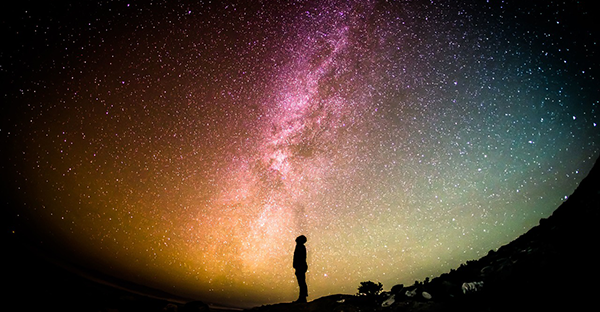
- Bold and in quotes: Original text of Baal HaSulam
- Regular: Commentaries of Rav Laitman
- lowercase italics: emphasized words
- Capitalized italics: transliteration from Hebrew
The science of Kabbalah did not come about as some product of human thought, detached from genuine reality. Rather, man investigated the surrounding reality as a whole and achieved a state when he revealed reality beyond the level of perception of his five senses. The science that studies this Upper Reality is called Kabbalah.
One of the people who revealed the Upper Reality was Abraham. He began to ask, “Where did I come from, why do I exist? Why do the sun, moon and stars revolve the way they do? What is this world and why does it need to exist? Who am I in this world?” As the Midrash narrates, Abraham began to ask these questions in spite of the fact that he previously thought that the world was nothing more than regular and familiar nature, being precisely the way we treat it.
The second example after Abraham is Moses. There was nothing particularly special about him either. People wrote that he was raised in Pharaoh’s house and he apparently received the corresponding upbringing. He was a prince and a favorite of Pharaoh’s daughter, Batya, and of Pharaoh himself. The Midrash narrates about how he behaved in Pharaoh’s house when he was a child and a young man. He was given everything a king’s son could receive. At a certain moment, the Creator became revealed to Moses and he ran away from Pharaoh’s house. That is, he perceived that he was unable to remain in his previous state any longer.
Abraham left his father Terach in the same way, since he was unable to remain within the boundaries of a materialistic worldview; he felt as if he was in prison. The Upper Nature or Upper Force became revealed to him as an answer to his questions, which were brought about by grief and disappointment. In this way, both Abraham and Moses discovered what exists beyond nature. Thanks to their revelations, other people followed in their footsteps, using their help and advice, and also attained the revelation of the Upper Nature. In addition, these people have told us about this.
The science of Kabbalah can become revealed naturally to literally every person, even to someone who does not read books, study in various institutions, or is a disciple of a sage. A moment occurs in a person’s life when he receives a push and ponders the question: “What is the meaning of my life, why do I live?” As a result, this question gives him potential access to the Upper Reality. Based on his attainment, he begins to understand why everything is made the way it is, and for what sake everything is constructed, what his role is in life, and what is the correct worldview.
In the article The Essence of the Wisdom of Kabbalah, Baal HaSulam says that the science of Kabbalah is a cause-and-effect order of the roots’ descent to man’s level. This gives man the opportunity to use these roots, or forces, to reveal the Upper Force, connect with it, and to thereby achieve the level of eternity and perfection. In other words, it gives man the ability to rise above the nature that man currently perceives, and to unify with the Upper Nature.
As Baal HaSulam says, this kind of attainment contains a general as well as a particular aspect. The particular aspect consists in the fact that there exist individual special souls. A huge desire unexpectedly surfaces in them and they independently penetrate beyond matter’s boundaries, attaining the forces and properties that control matter. These sort of people include the great Kabbalists, the spiritual leaders of the nation: Abraham, Moses, Rashbi and the ARI. In addition to the particular aspect, there is also the aspect of the general. Baal HaSulam says that all of humanity must ultimately attain the highest existing level in nature, called the World of Infinity, and attain its existence within this level.
If this is so, then why is our history so confusing, complex and incomprehensible? How can we see that all Upper Roots, as the Kabbalists narrate, gradually become revealed in this world and, ultimately, bring every person in particular and all of humanity as a whole to the question about the purpose of life, for us to ascend to a higher level, to a spiritual existence? How does this process transpire over the course of history?
We will discuss a table that has been prepared for me, and we will keep returning to it. Once we accumulate knowledge, we will be able to connect everything together in order to have an integral science about development in this world from up down and from down up. All of this will become clearer to us. Afterward we will place this table on our website in order for everyone to be able to see it.
As the science of Kabbalah teaches and as Kabbalists have clarified, there exists the Ratzon Lekabel, or the will to receive pleasure. All material of creation as a whole is the will to receive pleasure. It contains five levels of Aviut, or five levels of the desire’s size. There exist small desires, slightly greater desires, even greater desires, and so on, until the size of the desire of the fifth level. The desire can be depicted as a Kli or a vessel with five levels of Aviut: Shoresh (the root or level zero), Alef (the first level), Bet (the second), Gimel (third) and Dalet (fourth).
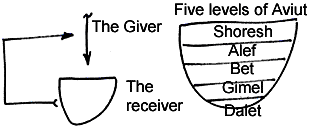
Drawing No. 1
Ultimately these levels of Aviut must help us correct our nature, meaning to change the nature of a receiver to the nature of a Giver. A mechanism of correction was created from the beginning in order to make this possible. According to this mechanism, the Kli undergoes the process of correction. Who determines this process? It was originally established by nature itself, whose attribute is absolute bestowal.
As Kabbalists tell us, the Upper Light (or termed differently, the Upper Nature or the Creator) desires only to bestow. He is the Giver. Therefore He created a desire to receive pleasure, or a receiver to whom He can give the greatest pleasure. This greatest pleasure is the level of the Giver Himself. Since the Giver relates to the receiver with love, He must correspondingly bring the receiver to the same state in which He Himself exists, since nothing better or more perfect exists. After all, only He who gives or who is capable of giving exists in perfection. He does not have any faults or needs, because He has everything.
Thus, the first law states that, on the one hand, the Giver, the Creator or nature (the Gimatria of the word Teva—nature, is identical to the word Elokim—God), must create a receiver or something opposite to Himself in order to have someone to give to. On the other hand, He must bring the receiver’s attributes to equivalence with the Giver. Sameness of attributes with the Giver is called closeness or union with Him.
We observe an analogous phenomenon in this world, in the relationships between people. When measuring the distance between two people according to their inner content (rather than their bodies’ spatial position) we must look at all the attributes of both people, compare them and analyze the degree to which one person’s attributes coincide with the other person’s attributes, or the degree to which they differ. According to this, we are able to tell the degree to which these people differ and how far away they are from each other.
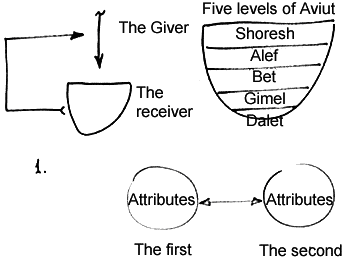
Drawing No. 2
In this way, when we compare people in our world we can evaluate them not only according to height, skin color and other external signs, but also according to their essence. People are either close to or distant from each other according to their worldviews, their character traits, their habits, and everything that comprises their essence. If two people are so far away from each other that one person’s opinions are one hundred per cent opposite to the other person’s opinions, then we say that they are polar opposites and an infinite abyss lies between them. Why is it infinite? It is because they do not have even a single point of contact. If two people have a kind of relationship where they are, for example, ninety per cent similar to each other, then the space between them is not very large. Only ten per cent separates them.
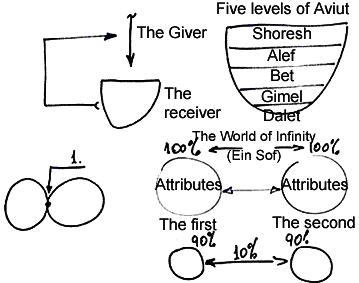
Drawing No. 3
Another way is to say that if two people have something in common then they have contact with each other in this aspect. For example, two people’s opinions are so similar that they are one person regarding this opinion. If they have more than one opinion in common, then they enter into each other (so to speak), that is, they have a common territory. These people can be accomplices with regard to many things.
If one person is exactly similar to another, then they unify together and there is nothing in one person that goes beyond the other’s boundaries. This phenomenon is called “union.” Literally every part of one person unifies with every part of the other, and their every part as well as the two as a whole become as one person. This is how people describe what occurs in the Spiritual World, because in this case they are not talking about bodies but rather about inner attributes. People use these concepts not only to talk about the Spiritual World, but also about things that relate to our world. For example, psychology uses concepts such as “close” or “far” when describing relationships between people.
Two people who are close to each other in spirit or according to their inner attributes, and who are separated by a distance of thousands of kilometers, do not cease to feel their closeness. We know of such a phenomenon as when a mother literally feels what is happening with her baby, who is located far away from her.
In this way, both in our world and in the Spiritual World, people measure closeness and farness between each other in the same way. However, in the Spiritual World, people contact each other with their desires and aspirations, which are oriented on that which is beyond our world. Thus, the receiver must attain the same state that the Giver is in. One who originally receives one hundred per cent is removed from the Giver. His attributes are so far away from the Giver’s attributes that the relationship between them is called “hate.”
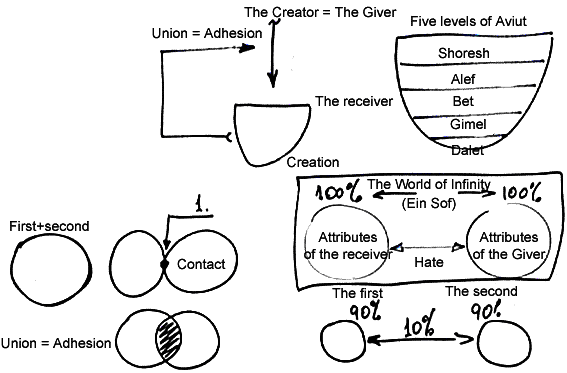
Drawing No. 4
This means that the receiver, or creation, does not contain even one thought or one desire that is similar to the Creator’s attributes. Therefore it is impossible to describe to the creation (which has not achieved even the slightest contact with the Creator), who the Creator is, what is the Upper Force, what is the Upper Nature and what is the attribute of bestowal. Creation cannot even imagine these things, since it is so far away from the Creator.
Question: Does this mean that the Creator hates us?
It is said that “The Creator hates bodies.” That is, he hates our external form. What is hate? In spirituality, the concept of “hate” means something completely different than what it means to us in this world. Hate signifies that there is no point of contact between two objects and there is no closeness between them. We can recall thousands of sayings on the topic that the Creator is good and kind and he does good for good and bad people. However, in spirituality, hate is the opposition of two objects or two states. In our world, when someone hates another person, this means he wishes evil for him. Here, however, we are talking about a total lack of mutual understanding.
A question arises: “Can it really be the case that the Creator does not understand creation?” However, we are not looking at the situation from the Creator’s point of view, but rather exclusively from the point of view of the creation. We are talking about the way in which we investigate the world. “People do not discuss that which their eyes cannot see.” Therefore we talk about the Creator only from the point of view of our perception. When you pray to the Creator, asking something from Him, wishing that you feel better, by doing this you are saying that He is bad, that He brings evil to you and does not love you. After all, you want the Creator to improve His treatment of you, isn’t that right? This is how we judge the Upper’s Relation toward us. “Every person judges to the degree of his own incorrection.” This is how we see and understand things.
Now let us return to our subject of discussion. We were originally created by the nature of the Giver in the form of the desire to receive pleasure, and we must bring our desire’s attributes to equivalence with the Giver, or union with Him. Only in this case do we become included in the state “He is Good and He does good” in an infinite and boundless form. This is the complete final goal of creation.
Why is it necessary for us to go through this entire process? It is necessary in order for specific categories to become formed in us that will allow us, beginning from the state when there is a great difference between us and the Creator and when we see how different we are from Him, to study this entire infinite contradiction, to understand what spirituality is and to begin to gradually come closer to it and build the best state for ourselves—the state of Infinity.
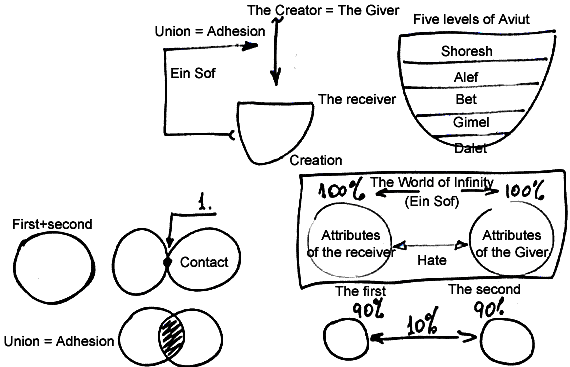
Drawing No. 5
Accordingly, in addition to the fact that a person independently creates the perfect state, he also becomes aware of it and therefore derives pleasure from it in literally every one of his desires, even within the smallest desire.
How does this occur? This process is called “three lines.” Kabbalists have discovered, and they tell us, that there is a Giver called the Creator Who created the Kli and then had to distance it from Himself, placing it in a state where it completely lacks the perception of the Creator’s Light. In other words, a total separation was formed between the Creator and creation. Since creation was created consisting of five parts of its desire to feel pleasure: Shoresh (the root), Alef (the first), Bet (the second), Gimel (the third) and Dalet (the fourth); there had to be a concealment for each of the parts in order for creation to be completely independent of the Light. This is why there exist five worlds: Adam Kadmon, Atzilut, Beria, Yetzira and Assiya.
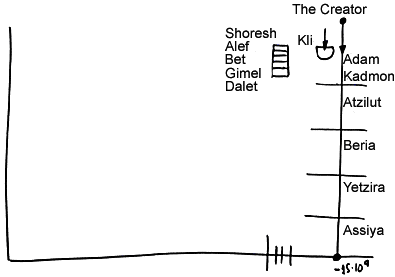
Drawing No. 6
There remains a point after all these concealments. All matter and our entire Universe were created within this point. This took place about fifteen billion years ago. The sun, the entire solar system and the earth formed about twelve billion years later. Life began to develop on Earth about three billion years ago.
As Baal HaSulam wrote, the forces of nature needed to interact with each other for millions more years until the surface of the earth formed, upon which plants were able to grow, and animals were able to reproduce and so on, until man began his existence. After many years of evolution, the geological process continued, and over its course human life emerged on Earth. Thus, the still or inanimate nature appears in the beginning, which is followed by the vegetative nature, then comes the animate nature, and finally the speaking or human nature.
Question: What existed before the material world began to form fifteen billion years ago?
Matter did not exist before the emergence of the world. After all, the matter of our world is located within our perception. There is a problem: how does reality appear when there is no one to perceive it? We always say that there is no reality without a person who perceives it. For example, you say that there is a star in the sky. How do you know? Let’s suppose someone saw it. But if he did not see it, then would this star exist or not? It would not exist, because it only exists in relation to the one who perceives it.
The problem is that we can never investigate, analyze and perceive that which is beyond the boundaries of our perception. It is for this reason that discussions about things no one has ever seen or felt are groundless. Therefore everything in science is divided into mysteries and discoveries; all of reality is divided into what we have attained and what we have not yet attained.
A question arises: do we even have the right to speak about reality that existed before man appeared in this world? We know that we apprehend all that we know of reality with our five senses. The picture that appears before us comes to us precisely in this way because our five senses are designed as such. Will I be able to perceive anything if I cancel all of my senses? I will not perceive anything. I will even cease to perceive myself. In other words, if we turn off all of a person’s senses (theoretically we are unable to do this, but let’s suppose that we can turn off one or two of our senses) a person will then not perceive himself and that which surrounds him. A question then arises: does anything exist or not? Nothing exists with regard to this person.
We can object and say that we are conducting an experiment with only one person. In the meantime other people perceive the reality around them. However, they perceive it in the same way as the person whose perceptions are turned off, or in other words, with their five senses. Will reality exist if we turn off all of their perceptions as well? We do not know. The fact of the matter is that our perception, which tells us that we are located within an existing reality, is produced by our senses. They depict the following picture before me: I and something outside of me. If I alter my senses, then I will perceive a different reality. We perceive this and clearly see this when we broaden our perception by way of studying the science of Kabbalah.
The issue of reality’s perception never presented itself as a problem for man before. This issue first emerged during Newton’s time. As he investigated nature he began to ponder the question: do nature’s laws exist on their own, or do they exist only relative to man? The scientists of that period developed a worldview that the laws they discovered were absolute. That is, they thought that the Universe and its laws exist regardless of whether or not man exists in the Universe. This concept is called Newtonian theory. This was the first time a formulated worldview was made by people who investigated the world in which they lived. I am not talking about Kabbalists, who revealed the truth ever since Abraham’s time by attaining the forces standing behind matter.
Newton, and other researchers and philosophers before him, made their discoveries inside of matter. Therefore a theory emerged that the world exists on its own, regardless of whether man lives in it or not. The development of science continued and scientists arrived at a state when they began to have doubts. Why?
It is known that various species of animals whose senses differ from ours perceive reality in a different way. For example, a dog sees much worse than a human, but it smells much more acutely. A dog’s sense of smell is highly developed, rather than its sight (which man uses to perceive ninety-nine per cent of information about his surrounding reality); and this allows the dog to perceive many shades of smell. This is how a dog perceives the world, and its perception is no worse than man’s. It constantly checks its entire environment with its nose.
Obviously, smell is a more limited sense than sight. Using sight, one can perceive something located at a relatively far distance, and sight can also be intensified. There are animals who do not have the same sense of smell as that of a dog, but they survive using other perceptions.
Thus, we do not know how reality appears in its true form since every type of creation perceives it in its own way. This means that our perception of reality is not absolute. If we broaden the boundaries of our senses’ perception, reality will appear differently. For example, if we alter a person’s range of sight from the regular light wavelength toward the direction of infrared, ultraviolet or radio waves, then he will see heat waves, infrared radiation, and so on. That is, my senses are built in such a way that what appears before us is a regularly perceivable reality.
However, this does not mean that reality by itself exists in this form.
As scientists developed biology, studying various living things and broadening their senses’ range of perception with the help of various devices, they saw that our perception is relative. Then Einstein came forth and said that literally every aspect of reality is relative and depends on the speed with which we move. The way I perceive any object changes when my speed of movement relative to the object I observe changes.
The comparison of speeds is of great importance. While moving at a constant speed, it is practically impossible to determine whether or not we are actually moving at all. We can only check the difference of the movement between two objects, or the speed of one object relative to another. However, a person who moves without changing speed thinks that he is at rest.
Then there was a different kind of problem. The issue is not how a person perceives reality, but rather that his perception is not merely the sum of his senses’ perceptions. In addition, it also depends on the way he interacts with his environment, and how similar or different he is to it.
Thus, the first theory asserts that everything I perceive is located outside of me and exists independently of whether I perceive anything or not. According to the second theory, what is located outside of me changes according to my attributes. When my attributes change, my perception changes accordingly, and what I see acquires a different form.
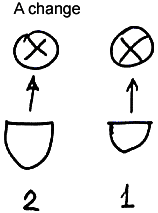
Drawing No. 7
For example, depending on whether I see our universe and our world in ultraviolet or infrared light, X rays or in any other form, then completely different images correspondingly appear before me. That is, everything depends on the changes occurring within me.
There is one more theory, which states that I perceive everything outside of me according to how I influence it. In other words, I do not see something that is absolutely separated from myself. Rather, with my feelings, I perceive a reality that changes according to changes that occur within me. When I investigate an object, whether or not I want to, I introduce changes to it. Therefore it is impossible to say what this object was like before I began to research it. In other words, I perceive a certain combination of myself and the object I observe. I do not perceive a world that exists by itself, but rather the world as I see it. The image appearing before me is the result of my attributes and the attributes of the world around me. This is another concept that exists. All aforementioned theories have various variations, and lots of time can be spent discussing them.
There also exists another worldview—the worldview of Kabbalists. Over the course of history this worldview did not develop within matter, as was the case with scientists who came to see and realize their limitations. Kabbalists developed their worldview by investigating the Upper Nature. They discovered that the Upper Nature is simple and unchanging Light, without any forms or images. In short, it is a single force that they defined as the Creator or Giver, since everything comes from Him. He is in the state of total rest and does not change in relation to us. It is a certain absolute. I perceive it according to the degree my attributes are the same as His attributes.
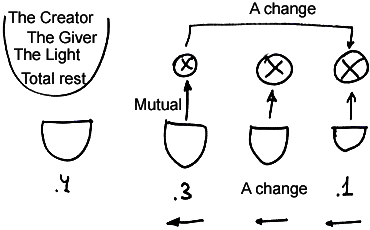
Drawing No. 8
Scientists have also come to the deduction that we perceive our reality according to the degree our attributes are the same as its attributes. My ear can hear only external sounds that correspond to the frequencies to which its inner mechanism is attuned. For example, my ear’s mechanism is attuned in such a way that it perceives the range of frequency from twenty to two-hundred thousand Hertz. This means that I hear only sounds whose frequency is from twenty to two-hundred thousand Hertz, no more and no less.
An old man whose sense of hearing is decreasing hears within the range of fifty to ten-thousand Hertz. He therefore thinks that there are no sounds of higher or lower frequencies outside of him. The same thing is true with regard to sight, and so on. Everything we perceive from the outside corresponds to the parameters that one of our senses is able to reproduce.
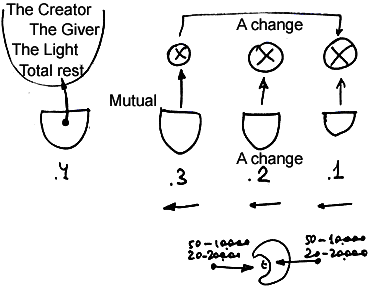
Drawing No. 9
Spiritual attainment is based on the same principle. As Kabbalists say, I am located within an ocean of the Upper Light that is absolute, altruistic and giving. On the other hand, my attributes are exactly opposite: I am the receiver and He is the Giver. Therefore our attributes are not the same. My entire internality is directed toward reception, while His entire externality is directed toward bestowal. For this reason I am unable to perceive or see Him. This is precisely the reason why He is concealed from me.
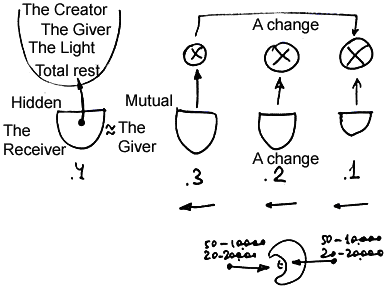
Drawing No. 10
In this case, what should I do? If I want to perceive the Upper Reality, I need to correct myself inside in such a way that I will be equivalent to the Giver. Then, to the degree I am equivalent to Him, I will begin to perceive the Upper Reality. When my attributes are completely distanced from Him, I do not perceive Him. When I have a point of contact with Him due to one equivalent attribute, I touch Him with this one point since I have corrected one of my attributes and I begin to perceive the Giver at least in some way.
Thus, when I correct my attributes I gradually perceive Him more and more until I finally reach the state when we are together. That is, in order to overcome the difference between the Creator and creation, the receiver must bring himself to sameness of attributes with the Light in order to become a part of It and to perceive It. To discover or reveal the Light means to perceive It.
Question: I would like to return to the example with the old man whose sense of hearing decreases. He has a memory that allows him to remember sounds he perceived in the past. In a way, he hears them. How can this be explained?
The old man’s sense of hearing has decreased. However, impressions about the way in which he once heard or saw remain in him from past experience. All of this is within his memory. Our memory is like a computer’s memory, where nothing disappears. The difficulty is only in taking out and renewing what is necessary from it. As in a video camera that records on film, everything passes through our senses, becomes fixed in our memory and remains there until it comes to life once again. Sometimes we unexpectedly remember something that happened thirty years ago. I can perceive a smell and it will remind me of events that happened twenty years ago. Today, when I suddenly perceive a smell or see something, I remember how I was a child in my mother’s house and the various things that happened there.
All feelings are recorded in memory along with the episode related to them. You can derive an entire image from your memory as if from a search engine by using just one of many parameters of a tiny image fixated in your memory such as smell, color, or another small fragment located outside of you, which reminds you about the past episode. There are many conditions that make it possible or impossible for you to derive something from your memory, and there are various techniques that teach people how to do this. (But we are concerned with something else; we do not need this.) Thus, through the senses all data becomes transferred to memory. It is the determining factor in these cases.
Since age weakens memory, a person ceases to recognize the reality before him. He is unable to derive yesterday’s events from his memory. The same image he saw yesterday is today, completely new for him. He may even be unable to remember what happened a moment ago. This is how a person loses his memory. In essence he does not lose it, but he is unable to derive anything from it.
Question: How do people use memory during spiritual advancement?
In the spiritual path we study our structure, and our feelings become more and more acute. We begin to use all our attributes and in addition, on their basis we acquire new attributes of a higher level. Attributes related to the body die together with the body. However, if we acquire new attributes that are beyond the body, meaning attributes of the Giver, we then remain forever with these attributes of the Giver. Baal HaSulam’s article “To which level does a person have to reach in order that he should not need to be reincarnated a second time?” speaks about this.
Question: Can a scientist today who studies nature in a scientific way arrive at Kabbalistic investigations?
A scientist observes nature through his five senses, various devices and his mind, without enacting the “point in the heart” that is connected to forces beyond nature, forces of bestowal. We have previously analyzed the structure of Adam ha Rishon. The Creator created a Kli which is called Adam ha Rishon. We are all located within it as elements of the general construction. Every part is a desire, a soul.
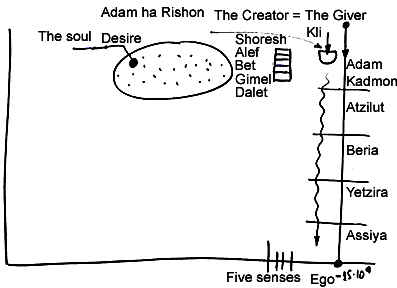
Drawing No. 11
In this initial state the desire’s nature is identical to the Giver. Afterward, the particular souls descended, meaning they lost their attributes’ equivalence to the Giver. Simply speaking, they became egoistic. These egoistic desires have five senses. It is in this way that scientists conduct experiments by way of the five senses that are used to perceive reality. This received information is processed by the egoistic mind.
If the question “What is the purpose of life, why do I live?” emerges in a person, a desire becomes revealed in him that remained within the ego in the form of a tiny point called “the divine particle from above.” Each of us contains this point, which gives us a vague feeling that we come from somewhere above, from another world. When this desire surfaces in a person, he does not know where it comes from, but he feels that it does not come from this world, and so he begins to yearn for something that is located beyond us.
When a person begins to investigate from this point, he becomes a Kabbalist. If he conducts his investigations by way of five senses, based on the ego, then he will simply be a scientist. Therefore the path of science ultimately leads to failure and, in principle, this is where scientists have arrived. Man’s development in all areas of his activity lead to the state of emptiness when he feels that all his activities do not give him anything, do not make the world better, and man remains empty. This is when the point becomes revealed called “the Creator’s particle from above” or “the point in the heart,” and after all sorts of scientific tricks, man begins to yearn for his root.
Question: Does a Kabbalist attain the beginning point?
When Kabbalists say that we must reach the Giver’s level, this means they attain Him completely and entirely. That is, they attain not only the point of our conception, but also the thought, desire, program, and existence prior to our birth or our creation. This is called, to become equal to the Giver. Equivalence of form with the Giver means to attain His mind and to be the same as Him.
As a person changes himself, he does this with his own forces and with his own free choice. As he ascends independently, step by step, he studies his own nature in comparison to the Giver’s nature and copies the Giver’s nature within himself. He corrects his own nature and by doing so he acquires the Creator’s mind and attains the Thought of Creation. In this manner, he ascends to the highest level, and becomes limitless, because the Upper Force is absolute in every way.
Question: Kabbalists say that everything outside of me is Light, and that which is inside of me is a sensor that perceives reality. In this case, why does nothing change when I want to immediately appear in Spain (for example), or change the image around me?
You are saying that around me is Light that contains many possibilities and variations, or all the images of the world. These fragments depend on me. As soon as I change my inner Kelim, combine them in a special way, place them in a special relationship with each other, I then immediately find myself in any reality I want to be in. This is correct. In this case, what is the problem? Is it to know how to do this? First of all, what kind of perception are you talking about? About the five earthly senses and the egoistic mind? Or are we talking about the five spiritual Kelim: Keter, Hochma, Bina, Zeir Anpin and Malchut with the altruistic desire or Masach (Screen)? Where do you want to transfer yourself?
We cannot move around within our earthly feelings and we cannot do anything with them. I am unable to connect my desires in such a way that I will see a different image, because these feelings are inanimate, dead, and they do not undergo correction. Even when I become the greatest Kabbalist, I still remain in my body with its organs of perception. When I get old, I will hear and see worse, even if I will perceive the world in its entirety in my spiritual Kelim. The five earthly feelings are constant in us. They are inanimate and we are unable to change them. It is impossible to see the world in X rays simply by desiring to do this, no matter what sage I may be.
Question: Where does this come from, if we are saying that a person is able to change himself?
You can change only that which you are able to change. The body’s attributes—the five senses and the accompanying egoistic attributes—do not undergo correction or change. What you are able to change is to attune the spiritual Kli above the “point in the heart” or above the “Creator’s particle from above,” to be equivalent to the Giver.

Drawing No. 12
This kind of Kli already exists. I receive a tiny particle within this Kli and I gradually rehabilitate this particle into an integral Kli whose attribute is equal to the Giver’s attribute. This Kli descended down into this world on purpose. Right now it is located within me in the form of a point of yearning for something; however, I do not know for what. I then gradually ascend back and become equivalent to the Creator with my attributes. This is precisely what undergoes change. However, I do not change within my five earthly senses.
inapoi la SURSE Michael Laitman – link
